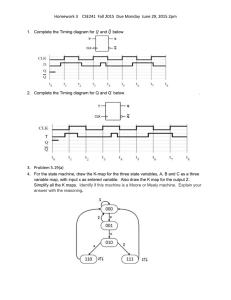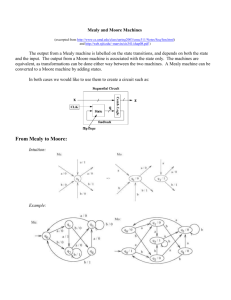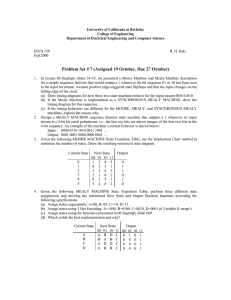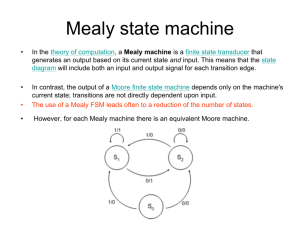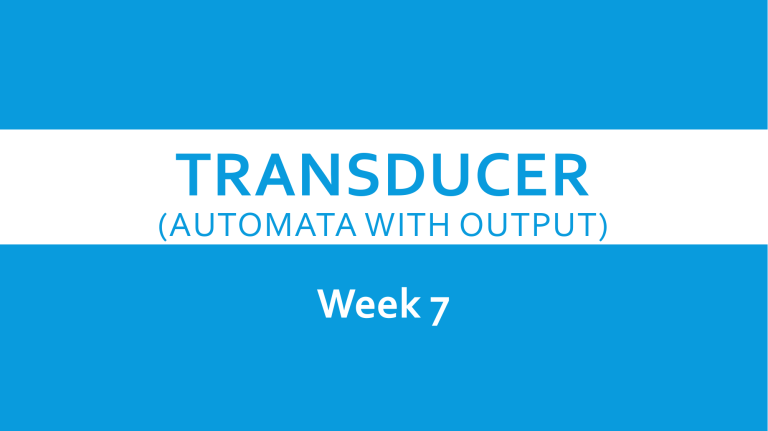
TRANSDUCER
(AUTOMATA WITH OUTPUT)
Week 7
TRANSDUCER
An automaton that produces outputs based on
current input and/or previous state is called a
transducer.
Transducers can be of two types:
Mealy Machine The output depends both on the
current state and the current input.
Moore Machine The output depends only on the
current state.
MEALY MACHINE
A Mealy Machine is an FSM whose output depends on the
present state as well as the present input.
It can be described by a 6 tuple (Q, Σ, O, δ, X, q0) where −
Q is a finite set of states.
Σ is a finite set of symbols called the input alphabet.
O is a finite set of symbols called the output alphabet.
δ is the input transition function where δ: Q × Σ → Q
X is the output transition function where X: Q × Σ → O
q0 is the initial state from where any input is processed (q0 ∈ Q).
QUESTION RELATED THIS TOPIC FOR
EXAMS
MOORE MACHINE
A Moore machine can be described by a 6 tuple (Q, Σ, O, δ,
X, q0) where:
Q is a finite set of states.
Σ is a finite set of symbols called the input alphabet.
O is a finite set of symbols called the output alphabet.
δ is the input transition function where δ: Q × Σ → Q
X is the output transition function where X: Q → O
q0 is the initial state from where any input is processed
(q0 ∈ Q).
EQUIVALENT MACHINES
Two machines are said to be equivalent if they print the
same output string when the same input string is run on
them.
Two Moore machines may be equivalent. Similarly two
Mealy machines may also be equivalent, but
A Moore machine can’t be equivalent to any Mealy machine.
However, ignoring the extra character printed by the Moore
machine, there exists a Mealy machine which is equivalent to
the Moore machine.
THEOREM
Statement:
For every Moore machine there is a Mealy machine that is equivalent to
it (ignoring the extra character printed by the Moore machine).
Proof:
Let M be a Moore machine, then shifting the output characters
corresponding to each state to the labels of corresponding incoming
transitions, machine thus obtained will be a Mealy machine equivalent
to M.
NOTE
It may be noted that while converting a Moore
machine into an equivalent Mealy machine, the output
character of a state will be ignored if there is no
incoming transition at that state.
A loop at a state is also supposed to be an incoming
transition.
Following is the example of converting a Moore
machine into an equivalent Mealy machine
MOORE MACHINE TO MEALY MACHINE
Input: Moore Machine
Output: Mealy Machine
Step 1 Take a blank Mealy Machine transition table format.
Step 2 Copy all the Moore Machine transition states into this table
format.
Step 3 Check the present states and their corresponding outputs in
the Moore
Machine state table; if for a state Qi output is m, copy it into the
output
columns of the Mealy Machine state table wherever Qi appears in the
next state.
THEOREM
Statement:
For every Mealy machine there is a Moore machine
that is equivalent to it (ignoring the extra character
printed by the Moore machine).
PROOF
Let M be a Mealy machine. At each state there are
two possibilities for incoming transitions
1. The incoming transitions have the same output character.
2. The incoming transitions have different output
characters.
If all the transitions have same output characters,
then shift that character to the corresponding state.
PROOF CONT…
If all the transitions have different output characters,
then the state will be converted to as many states as
the number of different output characters for these
transitions, which shows that if this happens at state
qi then qi will be converted to qi1 and qi2 i.e. if at qi
there are the transitions with two output characters
then qi1 for one character and qi2 for other character.
PROOF CONT…
Shift the output characters of the transitions to the
corresponding new states qi1 and qi2 . Moreover, these
new states qi1 and qi2 should behave like qi as well.
Continuing the process, the machine thus obtained,
will be a Moore machine equivalent to Mealy machine
M.
Following is a note
NOTE
It may be noted that if there is no incoming transition
at certain state then any of the output characters may
be associated with that state.
It may also be noted that if the initial state is
converted into more than one new states then only
one of these new states will be considered to be the
initial state. Following is an example
MEALY MACHINE TO MOORE MACHINE
Input: Mealy Machine
Output: Moore Machine
Step 1 Calculate the number of different outputs for each
state (Qi) that are
available in the state table of the Mealy machine.
Step 2 If all the outputs of Qi are same, copy state Qi. If it
has n distinct outputs, break Qi into n states as Qin where n
= 0, 1, 2.......
Step 3 If the output of the initial state is 1, insert a new
initial state at the beginning which gives 0 output.
Example:
Consider the Mealy machine shown aside, having the states q0, q1, q2, q3 , where
q0 is the start state and Running the string abbabbba over the above machine, the
corresponding output string will be 11011010, which
can be determined by the following table as well
It may be noted that in Mealy machine, the length of output string is equal to that of
input string.
CONSTRUCTING THE COMPLEMENTING
MACHINE
Example
Consider the following Mealy machine having the only state q0 as the start state
and
Σ = {0,1},
Γ= {0,1}
If 0011010 is run on this machine then the corresponding output string will be
1100101.
This machine is called Complementing machine.
CONSTRUCTING THE INCREMENTING
MACHINE
how 1 is added to a binary number.
It may be observed from the above that
If the right most bit of binary number, to be incremented, is 0, the output binary
number can be obtained by
converting the right most bit to 1 and remaining bits unchanged.
If the right most bit of binary number is 1 then the output can be obtained,
converting that 1 along with all its
concatenated 1’s to 0’s, then converting the next 0 to 1 and remaining bits
unchanged.
The observations (a) and (b) help to construct the following Incrementing (Mealy)
CONSTRUCT THE INCREMENTING (MEALY)
MACHINE.
The Mealy machine have the states q0, q1, q2 , where q0 is the start
state and
Σ = {0,1},
Γ={0,1}
CONSTRUCT THE INCREMENTING (MEALY)
MACHINE.
It may be observed that, in the incrementing machine,
if 0 is read at initial state q0, that 0 is converted to 1
and a no change state q1 (no carry state) is entered
where all 0’s and all 1’s remain unchanged. If 1 is read
at initial state, that 1 is converted to 0 and the state
q2(owe carry state) is entered, where all 1’s are
converted to 0’s and at that state if 0 is read that 0 is
converted to 1 and the machine goes to no change
state.If the strings 100101110 and 1001100111 are run
over this machine, the corresponding output strings
will be 100101111 and 1001101000 respectively.
APPLICATIONS OF INCREMENTING AND
COMPLEMENTING MACHINES
1’s complementing and incrementing machines which
are basically Mealy machines are very much helpful in
computing.
The incrementing machine helps in building a machine
that can perform the addition of binary numbers.
Using the complementing machine along with
incrementing machine, one can build a machine that
can perform the subtraction of binary numbers.
SUBTRACTING A BINARY NUMBER FROM
ANOTHER
Method
To subtract a binary number b from a binary number a
Add 1’s complement of b to a (ignoring the overflow, if any)
Increase the result, in magnitude, by 1 (use the incrementing machine ). Ignoring
the overflow if any.
Note: If there is no overflow in (1). Take 1’s complement once again in (2), instead.
This situation occurs when
b is greater than a, in magnitude. Following is an example of subtraction of binary
numbers
